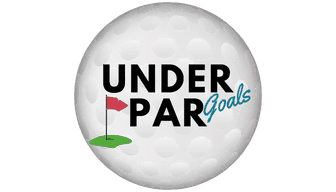Updated February 2024
You’re starting to see some improvement in your game and your handicap is showing it. Reaching that mid-handicap level (10-18 or so) is the perfect time to upgrade your irons.
My top pick for mid-handicappers is the Callaway Paradym Ai Smoke Irons because they perfectly bridge the gap between forgiveness and control for the golfer that’s improving.
But keep reading to check out my full breakdown and some other options that may fit your specific needs better…
The product links in this article are affiliate links, which means we get a small commission when you use them to buy. It doesn’t cost you more and helps to support this website.
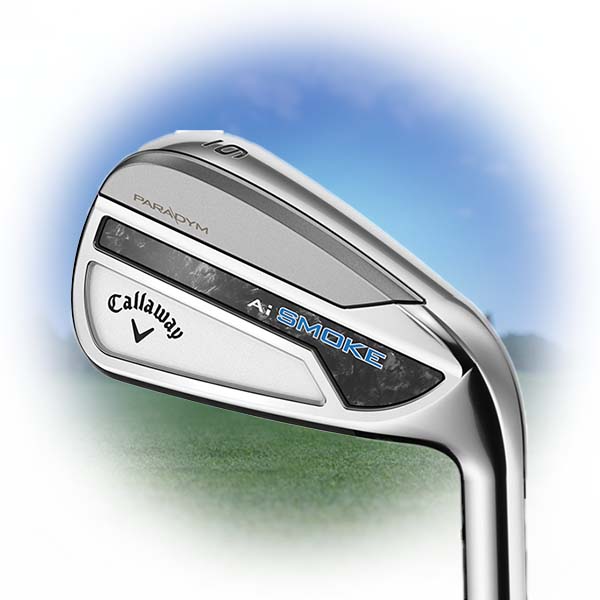
1. Callaway Paradym Ai Smoke
The Ai Smoke asks for a little more than some clubs designed for mid-handicap golfers, but the control and consistent ball flight will prove to you why they’re our top pick.
At long last, we have a game improvement iron designed for the golfer already at a 15-handicap looking to go down to a 10.
While so many other iron sets for mid handicappers target the players beginning to break 100, this set is different. Callaway Paradym Ai Smoke irons are what you buy after advancing to mid-handicap and learning rhythm. In many ways, these are designed for an existing swing and not improving it, the way most game improvement irons are.
Among the entire Paradym lineup, Ai Smoke’s are best fit for players with swing speeds in the 80s and 90s. Only the stock Paradym’s are fit for players that swing harder. Ai Smoke HL and Ai Smoke Max First irons are designed for higher handicaps and those who swing at below average speeds.
Pros
Cons
Hollow and cavity back designs helps add distance
Built for control and minimizing shot dispersion.
Faster ball speed off the face
Players with slow swing speeds lose accuracy but add distance.
Golfers who are not true mid handicappers will struggle with consistency.
The biggest innovation of Paradym Ai Smoke irons is a combination upgrade of shaft and head. It is common knowledge shorter swings and shorter clubs promote accuracy but hurt distance.
For these, Callaway increased the length of their mid irons by ½”. Nothing huge, nothing overly noticeable, but it does account for adding a few yards to each club. In the past, the tradeoff for these yards would be diminished accuracy.
Not anymore. Slight changes to the head and an upgraded sole design help retain the shot spread you would see with standard length irons.
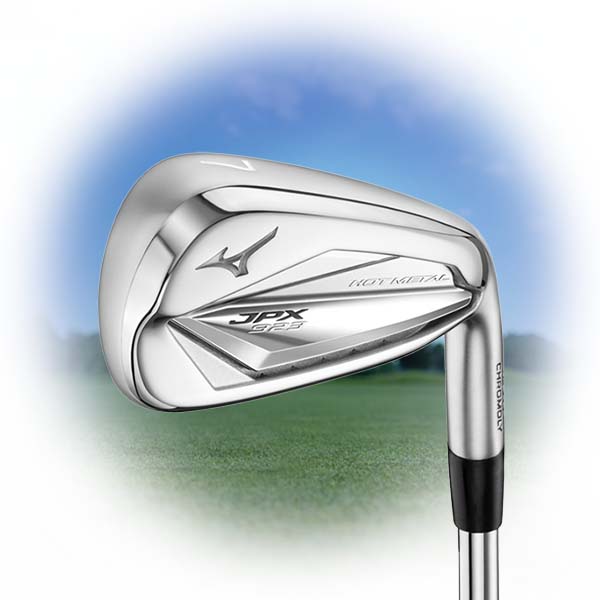
2.Mizuno JPX 923 Hot Metal
Whether swing speed, ball flight, or overall consistency is your top concern, the JPX 923 Hot Metal irons will put you at ease when standing over the ball.
Mizuno is a brand that has always made great clubs but had a low-handicap focus. In the last decade, they began promoting their brand to a wider range of golfers by creating better and better options for average players. Cue the JPX 923 Hot Metal.
A mid handicapper does not always strike the center of the face. This part of their game is one of the biggest reasons they do not get from tee to green in two shots and get quite a bit of practice on 30-yard pitch shots.
While the half wedge is a skill you don’t want to lose, who doesn’t prefer earlier putting opportunities? To build consistency, Mizuno enlarged the sole of JPX 923 Hot Metal irons towards the heel. This effectively expands the sweet spot by generating the same amount of speed and spin across a greater surface area. And unlike other clubs who enlarge the entire sole, focusing only on the “thinner” areas does not change the profile of the club.
Pros
Cons
New Nickel Chromoly formula used for the heads is stronger than previous Mizuno irons making it more durable
Slight offset helps with keeping the ball straight.
Players with good ball flight may hit these a bit too high.
Adjusting that dimension wasn’t enough though. By upgrading the materials used in the head, they were able to make the clubface itself thinner.
When you combine the enlarged sole and thinner face, you get a club that adds ball speed and not only maintains consistency levels but boosts them.
If we had a category for best irons for mid handicappers who do not make good contact, this would be the clear winner. But for now, runner-up works.
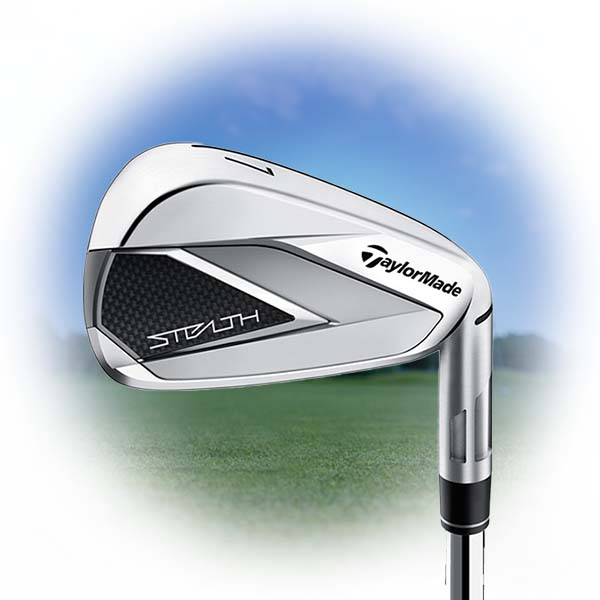
3. TaylorMade Stealth
Good enough to qualify as a top pick a year ago, the price drop on TaylorMade Stealth clubs makes them an automatic option for those shopping on a budget.
The clubs haven’t changed. Just the year we are in. 2022, 2024, or 2030, Stealth irons play well.
One thing we like to look for is how well a certain set fits into the standard bag of an average golfer. At the mid-handicap level, you probably aren’t pulling 3 or 4-iron with regularity. Or you might not have the room either. The loft dispersion of Stealth irons solve this problem by strengthening the lofts of longer irons.
While most 5-irons are around 24°, a Stealth 5-iron is 21°. You don’t need a 4-iron because you already have it. By taking out a longer iron, you gain an additional spot for a hybrid or wood—clubs players at this level are more comfortable using.
Pros
Cons
One of the highest launching options for mid handicappers.
Neutral flight bias plays well for those who can shape the ball.
High spin rates could cause trouble for golfers with unpredictable shot shapes.
As you work your way towards the lower irons, the difference between industry standard and Stealth decreases. Even so, you don’t want to forget that distance is heavily tied to loft. If you’re testing the same club in this set and another, you will hit these further.
Besides distance, feel and forgiveness are top priorities. Two areas Stealth irons excel in. TaylorMade takes advantage of a mostly hollow head by adding in a vibration dampening system. It reduces responsiveness just a hair but takes away unwanted energy before it makes its way up the shaft after contact.
The hollow design also plays a role on the forgiveness side. Rather than a concentrated sweet spot, this design successfully creates several small ones spread around the face.
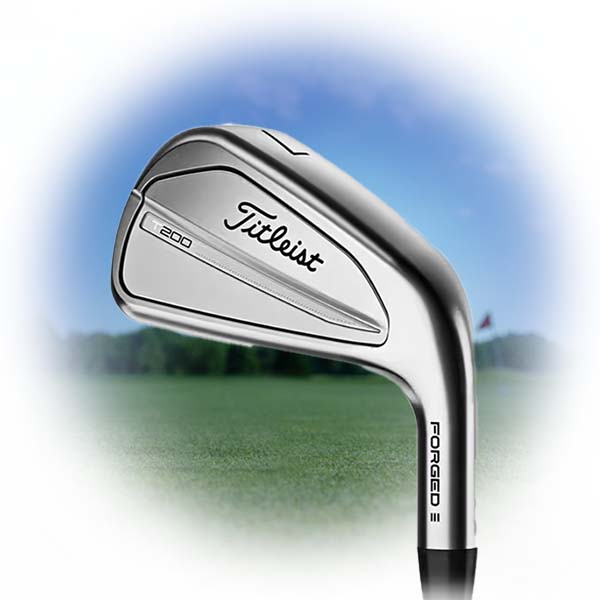
4. Titleist T200
They might not be the easiest clubs in our article to hit, but the way balls come off T200 irons make them impossible to leave out.
Best for good ball strikers who may have once played blades or are on the cusp of graduating to a low handicap, you won’t find better irons to transition with.
Typically, we wouldn’t include a set of irons designed for as good of golfers as these on this list. But there are exceptions. Exceptions that come when a brand successfully combines a low handicapper club with a mid handicapper control boost.
That said, the Titleist T200 are only viable for those teetering between low and mid handicap.
Even with a blade-like design, Titleist succeeds in making a club that does not require significantly above average speeds to generate good or consistent contact. However, it does require accuracy.
Pros
Cons
There is a seamless transition from long to short iron. Each club will feel the same.
An evenness throughout the face adds consistency to shots from varying terrains.
Minimal forgiveness when compared to other mid handicapper clubs.
Best for golfers used to playing clubs designed for low handicappers, but want some help
Do not expect shots off the toe or heel to fly as well as they might with other options in our guide. Do expect shots off center face to fly beyond the competitors.
Also of note, T200s share a similar sole with T100s. While this lets more skilled golfers have an easier time from varying lies, it’s another reason these clubs are reserved for better ball strikers.
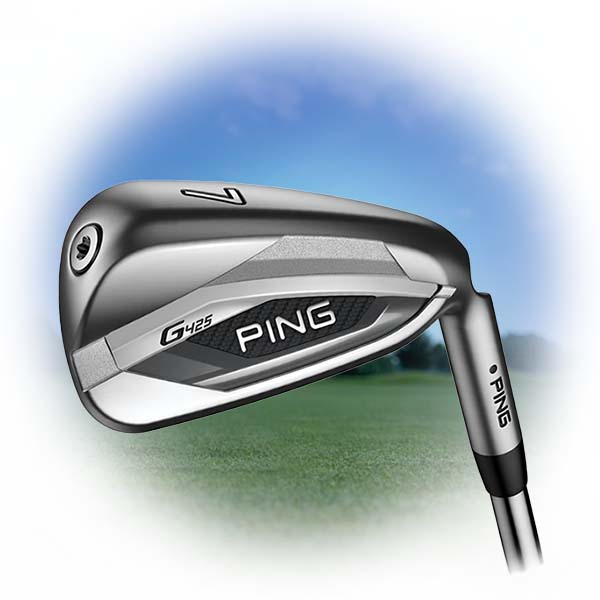
5. Ping G425
These are best for our mid-handicappers that focus more on tempo than they do speed.
You do not need to swing the Ping G425s hard or make perfectly square contact to cozy a shot from the fairway up to the flag.
Ping G425 irons reward tempo, not speed.
We see these as the best option for golfers beginning to lose swing speed. Regardless of whether you were once a low handicapper or never broke the 90 mark, a slow swing speed actually works to your advantage.
You do not need to improve your swing plane, angle of attack, or any of the other hot topic swing components you read about. Nope. All you need is a smooth swing and the club does the work for you.
Pros
Cons
Easy transition from players to game improvement clubs, as well as steel to graphite shafts.
A top choice among senior mid handicappers.
Don’t expect to substantially shape the ball.
Golfers with swings above 85mph will have many of the benefits cancelled out.
Perimeter weighting cancels out many of the bad effects of off-center contact. A low center of gravity helps to launch the ball. A multi-piece design helps to add speed. This is a club that works for you.
This is the type of club where you can embrace what you have, rather than trying to find ways to be more aggressive with each swing. For a golfer than lets the game come to them, rather than trying different shots with each swing, this is the one.
4 Irons For Mid-Handicappers to Avoid
There are a lot of good irons out there and even some of the really good ones may not be right for your game.
Here are some irons that I’ve seen recommended for mid-handicappers that probably aren’t the best choice.
TaylorMade Qi HL Irons
There is no doubt you will be able to hit TaylorMade Qi HL irons with ease. Yet, at the mid-handicap level, you should start to look for a little more.
Weak lofts will have you pulling 7 where you normally pull 8. Additionally, with such a focus on improving ball and swing speed, there is little margin for error when trying to work the ball. If a stock swing is all you play, this product line isn’t a bad option.
For a TaylorMade loyalist, you’re better off going to with the standard TaylorMade Qi irons.
Mizuno JPX 923 Hot Metal HL
A lot of the caution around JPX 923 Hot Metal HL irons comes from shaft selection. Because these clubs are engineered for mid to high-handicap golfers with low swing speed, graphite shafts are your only option.
If your swing speed is average, you won’t be able to attack shots with the level of consistency you do the JPX 923 Hot Metal irons detailed earlier in this article. With those, you have more options and can build a set of irons that work for your swing—not the other way around.
Callaway Paradym
Callaway Paradym irons should be avoided by mid-handicappers for the opposite reason as the first two iron models in this section.
Paradym irons are reserved for excellent ball strikers with above average swing speeds. If you’re a middle of road type golfer, chances are you only have one of those attributes.
With so many other options that will fit your game better, there’s no reason to go with clubs that do not accommodate you.
Any kind of blades
If the clubs to avoid listed in this section came as any surprise, that’s okay. There are variations of clubs that despite having similar names and profiles are for very different types of golfers.
With blades, there shouldn’t be any doubt. Unless you are an elite player with precision striking, incredible speed and control, and ungodly confidence, leave the blades to those playing the game as a profession.
What Mid Handicappers Should Look For When Choosing Irons
As a player that is starting to improve your swing and get some good results, this is a great time to think about upgrading your clubs, especially if you have been playing with clubs designed for players of a lesser skill level.
Adjustability
Adjustability in irons is different than in many modern drivers. You’re not likely to find irons with an adjustable hosel to give you a variety of loft and lie choices.
When it comes to irons, you’ll be better off if you choose clubs that are able to be bent to the correct lie angle. Having the correct lie angle is critical in hitting the ball on a consistent path.
What you may not know is that the correct lie angle for you may change as you improve your swing. A lot of golfers start off with a very steep swing and need an upright lie angle but their swing becomes more shallow as they improve and they require a flatter lie angle.
Clubs that are made from a casting process are often difficult or impossible to bend without breaking. That means you are stuck with the lie angle you had when you purchased.
Forged clubs tend to be a little more expensive but are easily adjusted at many golf shops.
Forgiveness
Your game is improving, but you don’t want to jump all the way to player’s irons with minimal forgiveness.
As a mid handicapper, you’re still going to miss the sweet spot on a regular basis, so while the super game improvement irons may not be right for you anymore, you still want to choose irons with some forgiveness.
Ball Control
As your game is improving, you’ll start to learn that just simply hitting the ball straight every time is both difficult and less effective than being able to curve the ball a little.
You may also want to hit the ball higher or lower depending on the shot you need.
The problem is that very forgiving clubs are designed to hit the ball straight all the time which makes them less effective for controlling your shots.
That’s why the mid handicap level is a great time to invest in some new irons.
The best irons for mid handicappers are a little smaller in size, have a little less forgiveness, but that comes with more ball control.
Loft
Most golfers just assume that all irons of the same number are the same loft.
That’s actually not true.
A 5 iron can vary in loft as much as 4 or even 5 degrees from manufacturer to manufacturer and even model to model.
This is particularly important to pay attention to when you already have clubs you like on either end of the irons, such as the wedges on the short end or a hybrid or fairway wood on the long end. You want to make sure that the gap in loft from club to club is not too small or too large.
The trend in modern clubs, especially game improvement clubs, is to make the lofts stronger (meaning lower loft and more distance). There is two reasons for this.
First, manufacturers like it when you pick up a particular club and their iron results in a farther shot than the comparable iron in another set.
Second, game improvement irons typically have a lower center of gravity. This helps you get the ball in the air better with a less than ideal swing. But that lower COG means that the ball will fly higher, so the manufacturer lowers the loft to preventing shots that go too high and not far enough.
When choosing a set, be sure to keep about a 4-5 degree gap between your clubs. That should spread out your distances nicely.
With the stronger lofts of today, that often means dropping a 3 or 4 iron and adding an extra wedge.
Preferred Ball Flight
Somewhat related to ball control, ball flight can vary depending on the model of irons you use.
Some clubs will get the ball up in the air faster and higher while others will give you a lower and more penetrating ball flight. This might be something you never considered before, but as you improve, you’ll realize that ball flight is very important.
When you first start playing, clubs with a low center of gravity that helps get the ball up quicker can be helpful. But as you improve and are able to hit your irons on the sweet spot more consistently, having clubs that will naturally have a lower ball flight will be more helpful.
Yet another reason this is a good skill level to think about upgrading your clubs.
Common Questions
Should I Buy Irons Online?
Buying online is a great way to get the best prices on a set of irons. I recommend buying from a store that has a favorable return policy in the event that the clubs turn out not to be right for you. You can also check out our guide to Online Golf Stores.
There are two things you want to be aware of though. First, forged irons are able to have their lie angle adjusted so you can take care of that after you get them and decide you want to keep them. Second, be sure the place you buy them has a decent return policy in case you hate them.
You can also rent different types of clubs before you buy, just to be certain.
What is considered a mid handicapper?
There’s no strict rule that says when you’re considered a “mid handicapper.” But generally speaking, a mid handicap player has a USGA handicap index of 11-20. Mid handicap players are those that are able to hit the ball solidly on a regular basis and tend to shoot in the high 80s and low 90s. They still need some forgiveness in their clubs but not so much that it prevents them from being able to control different ball flights.
When Should I Consider Buying An Iron Set For Mid Handicappers?
You should consider upgrading your clubs when you are able to shoot rounds in the high 80s on a consistent or semi-consistent basis. Once you reach that scoring level, beginner clubs and starter sets might be holding you back. At that level, you also are likely to have a more consistent swing so getting an iron set adjusted to the appropriate lie angle for you will also give you better results.
Should I Choose Steel or Graphite Shafts For My Irons?
Most players would be better off using steel shafts in their irons. Steel shafts are a little heavier and sturdier and will allow you to have more control over the club. Because clubhead speed is less important in iron shots than drives, you’ll be better off with the steel shafts. However, if you struggle to create enough swing speed to get the ball on a good trajectory, then graphite shafts may help.

